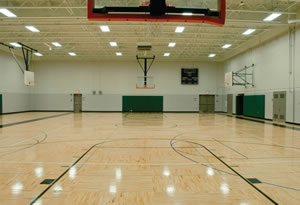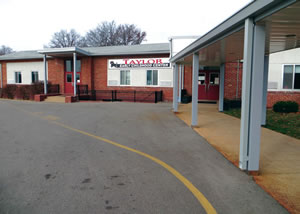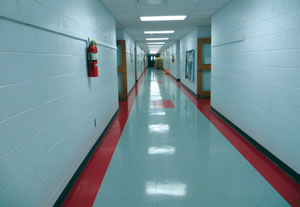Creating a Brighter Future
- By Craig Hall, Neil Maldeis
- 04/01/14

PHOTOS COURTESY OF INGERSOLL RAND
School building energy and operating costs are taking an increasingly large bite out of the average district’s budget these days, which has caused energy efficiency to move up on most administrators’ to-do lists for 2014.
After all, K-12 school districts in the United States collectively spend more than $6 billion a year on energy, which is more than they spend on textbooks and computers combined, according to the U.S. government’s Energy Star program. Most districts spend more on energy than anything else, with the exception of salaries and benefits. And the U.S. Department of Energy (DOE) estimates that as much as 30 percent of a typical school’s energy buy is wasted because of inefficient and often aging structures, building systems and operating practices.
Energy consumption can vary dramatically from one school to another based on climate, building design, construction, facility and equipment age, and a variety of other factors. But the Energy Information Administration (EIA) notes that as much as 70 percent of the typical school’s energy use goes for lighting, cooling, space heating and ventilation.
Taking steps to improve energy efficiency can create a win-win opportunity for school districts, which can reduce their energy costs, shrink their environmental footprint, and create a better, more comfortable learning environment for students, teachers and administrative staff. Energy efficiency measures can often be implemented with little upfront capital cost and will provide an excellent return on investment, paying for themselves many times over the decades-long occupied life of a typical school building.

(Energy) Wise Decisions. Administrators at Dunklin R-V School District, located in suburban St. Louis, expect recently completed infrastructure and lighting updates to save nearly $27,000 a year while improving the academic environment and avoiding future capital costs of up to nearly $300,000 a year.
Energy audits uncover efficiency improvement opportunities
Administrators implementing an energy-efficiency strategy can start by conducting an energy audit, which provides vital information about school building performance, uncovers energy conservation opportunities and makes sure heating, ventilation and air conditioning (HVAC), lighting and other building systems are operating effectively and efficiently. Many organizations partner with an energy services company (ESCO) or other qualified third party to conduct building audits.
Well-conducted energy and lighting audits uncover opportunities to reduce energy consumption and improve the classroom environment by upgrading indoor and outdoor lighting technologies. This process often includes updating older technology lighting fixtures, ballasts and lamps with the latest in light-emitting diode (LED) solutions. Today’s advanced LED technologies use less energy, require less maintenance, offer better lighting coverage, and enhance the security of the school and its grounds. According to Energy Star, a comprehensive lighting retrofit can reduce lighting costs by 30-50 percent in the school environment.
A lighting audit also may identify opportunities to increase daylight harvesting, which has been shown in multiple studies to both reduce energy costs and improve classroom performance. A recent study by the Energy Center of Wisconsin demonstrated energy savings of 20 percent, or about $1.13 per square foot per year, in a test classroom in which daylighting was used.
Meanwhile, a study of the test scores of more than 21,000 students in three states, commissioned by the Pacific Gas and Electric Co., found that students performed better in classrooms with more daylight. In one district, students with the most daylight in their classrooms progressed 20 percent faster on math tests and 26 percent faster on reading tests than students in classrooms with the least daylight.
Integrated lighting control systems use sensors, actuators and building automation system (BAS) technologies to maximize the amount of daylight in a particular classroom, supplementing outdoor lighting with artificial lighting to maintain consistent and ideal lighting levels.
HVAC also plays a critical role in creating an ideal learning environment that is safer, healthier and more comfortable. For example, modern HVAC technologies can help districts maintain optimum indoor temperature and humidity levels and deal with ongoing issues like indoor air quality and building acoustics, which are a particular challenge given the nation’s rapidly aging educational infrastructure. A recent McGraw-Hill study found that 91 percent of K-12 school leaders believe that green schools have improved the health and wellbeing of their students and 70 percent see a direct correlation with higher test scores.
Heating and cooling also places big demands on a district’s energy budget, so naturally many of the energy efficiency measures identified in an energy audit relate to the HVAC system. HVAC energy efficiency improvement opportunities can range from simple adjustments to the building’s BAS, to installing variable air volume fans, to upgrading or replacing major system elements like the chilled water system, to implementing breakthrough technologies such as thermal storage systems.

A Different Light. Lighting upgrades, shown here in the Taylor Early Childhood Center at Dunklin R-V School District in suburban St. Louis, included retrofitting existing fluorescent lighting fixtures, with energy saver T8 lamps and electronic ballasts.
Integration of lighting, HVAC raises the bar on energy savings
In most of today’s school buildings, lighting and HVAC systems are operated independently, which requires facility professionals to monitor and adjust the settings on two different systems. But today’s advanced BAS technology is taking energy management to the next level by integrating lighting and HVAC controls into a single automated platform. The result is greater comfort for building occupants and reduced energy consumption for the school district.
Integrating and networking lighting and HVAC controls creates a powerful energy efficiency capability for any type of building, but school buildings are particularly well-suited for implementation of this technology solution. Schools face a variety of unique lighting and operating challenges that are related to wide swings in scheduling and occupancy rates. Use of a single BAS-based platform to control lighting and HVAC can help schools make the most of their energy spend and avoid heating, cooling and lighting unoccupied spaces.
Developed by leading providers of lighting and comfort solutions, the most advanced platforms offer one-system simplicity, which means that facility teams can manage the system from a single user-friendly dashboard rather than making manual adjustments on multiple platforms. Dashboards can be accessed remotely from any computer or mobile device via an Internet connection, providing the operator with unprecedented levels of usability and flexibility.
Integrated lighting and HVAC controls work together to create a comfortable learning and teaching environment indoors. For example, they can share the same sensors to determine whether a classroom is occupied and automatically adjust the lighting and temperature to ideal settings. By the same token, the BAS can turn off lights and raise or lower the temperature to save energy when class is over and the classroom is empty.
Settings can be easily customized to meet the specific needs of different types of classrooms or school common areas. For example, the HVAC system can be programmed to pre-cool the gymnasium before the big game on Friday night, and ventilation needs are different in a chemistry lab or cafeteria than in a classroom used to teach English or history. The platform can even be programmed to provide teachers with the ability to control lighting and temperature in their classroom, within predetermined parameters.
The good news is that most schools already have the technology backbone in place to accommodate the integration of lighting and HVAC controls with their existing BAS or with an upgraded system. Opportunities to improve BAS capabilities are often identified by the ESCO during an energy audit. The ESCO can help the school district identify, prioritize and implement energy efficiency measures, many of which pay for themselves in five years or less.
Districts can choose to finance their energy-efficiency initiatives using an energy performance contract, which provides the opportunity to make improvements with little or no upfront cost and pay for them with future energy savings. Various federal, state, local and utility grants and financing programs may also be available for districts making energy efficiency improvements. ESCO representatives can help districts explore financing options.
School districts nationwide continue to look for ways to do more with less without negatively impacting their primary mission of creating a secure, comfortable and productive learning environment. Saving energy by improving lighting and HVAC technologies and integrating controls provides an excellent opportunity to reduce costs, improve environmental performance and create a better place for students to learn and faculty to teach.
This article originally appeared in the issue of .